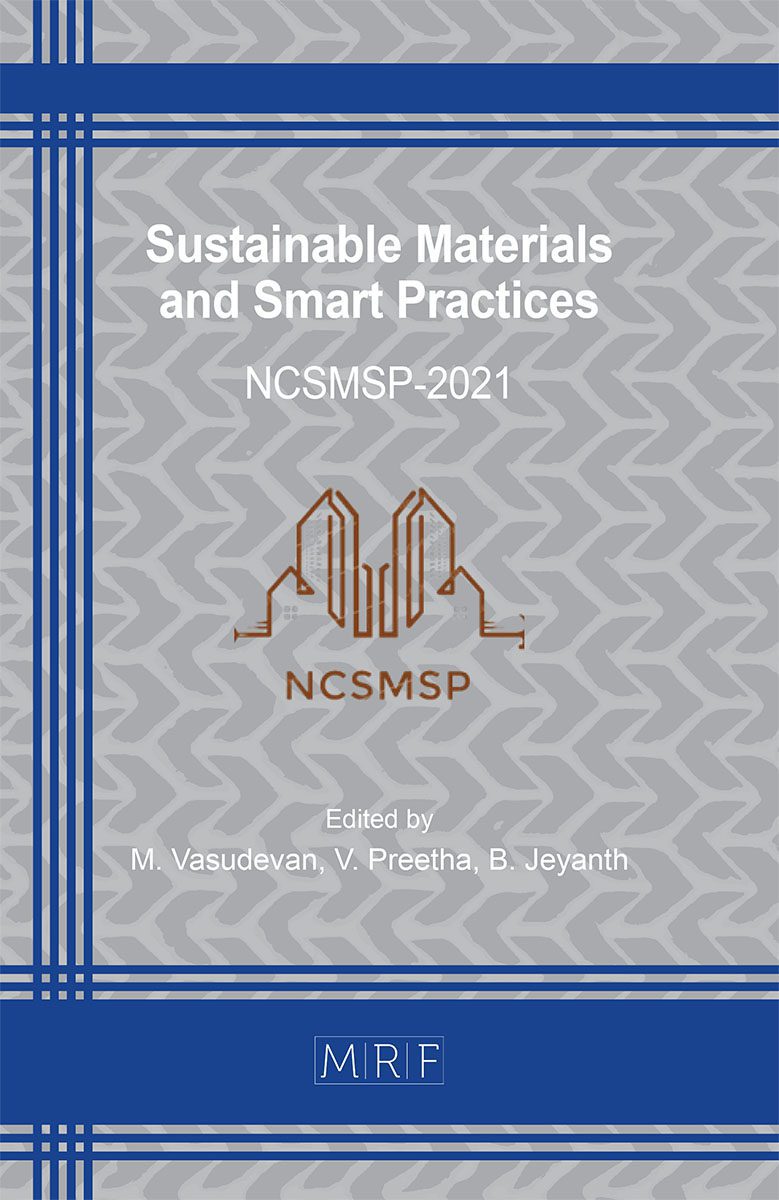Investigation on Strength Properties of Concrete using Steel Slag as a Partial Replacement for Fine Aggregate
R. Ashwathi, G.T. Amudhan Vetrivel, M. Abishek
download PDFAbstract. The economic and ecological performance of normal concrete can be increased by modulating fine aggregate content with a series of combinations of steel slag which possess different physical and chemical behaviour based on its cooling method, heating processes. Many research shows that magnetic separating of steel slag increases its efficiency towards integrating with clinker by 50% compared to integrating of clinker with non-magnetically separated steel slag. It has proved to be an impressive replacement material in concrete surfaces where high skid resistance is essential. Steel slag produced in various types of furnaces have different characteristic nature, blast furnace slag (BFS) has hydraulic and cement properties when used in water-bound macadam roads and also in flexible and rigid pavements. Issue in steel slag is energy consumed in its production and transportation where it is utilized, if energy consumed in slag grinding/magnetic separation is high when compared to cement calcining and grinding, then it would not be economical in replacement criteria. This study exhibit mechanical properties of concrete with partial replacement of fine aggregate with steel slag in distinct proportions. The optimum amount of replacement in fine aggregate is found to be 20% giving a strength increment of 8% in the compressive strength category. In split tensile and flexural strength criteria strength increment of 7.5% and 40.625% is observed. There are many practical implications of steel slag in the construction industry, road constructions, and clinker substitutes as granulated BF slag, water treatment plants, evidently many researches have proved slag as productive coarse aggregates replacement.
Keywords
Fine Aggregate Replacement, Mechanical Strength Properties, Steel Slag, Eco-Safety, Concrete Conglomerates
Published online , 18 pages
Copyright © 2022 by the author(s)
Published under license by Materials Research Forum LLC., Millersville PA, USA
Citation: R. Ashwathi, G.T. Amudhan Vetrivel, M. Abishek, Investigation on Strength Properties of Concrete using Steel Slag as a Partial Replacement for Fine Aggregate, Materials Research Proceedings, Vol. 23, pp 401-418, 2022
DOI: https://doi.org/10.21741/9781644901953-44
The article was published as article 44 of the book Sustainable Materials and Smart Practices
![]() Content from this work may be used under the terms of the Creative Commons Attribution 3.0 licence. Any further distribution of this work must maintain attribution to the author(s) and the title of the work, journal citation and DOI.
Content from this work may be used under the terms of the Creative Commons Attribution 3.0 licence. Any further distribution of this work must maintain attribution to the author(s) and the title of the work, journal citation and DOI.
References
[1] Parron-Rubio, M.E.; Perez-Garcia, F.; Gonzalez-Herrera, A.; Oliveira, M.J.; Rubio-Cintas, M.D. Slag Substitution as a Cementing Material in Concrete: Mechanical, Physical and Environmental Properties. Materials 2019, 12, 2845. https://doi.org/10.3390/ma12182845 https://doi.org/10.3390/ma12182845
[2] Mani V, Dinesh Kumar S, Gaayathri Priya N, Poornima, 2016, Replacement of Coarse Aggregate using Steel Slag in Concrete, international journal of engineering research & technology (IJERT) SNIPE – 2016 (Volume 4 – Issue 25),
[3] Das, KK, Lam, ESS, Tang, HH. Partial replacement of cement by ground granulated blast furnace slag and silica fume in two-stage concrete (preplaced aggregate concrete). Structural Concrete. 2021; 22 (Suppl. 1): E466- E473. https://doi.org/10.1002/suco.201900494 https://doi.org/10.1002/suco.201900494
[4] Irfan, H & Anil, K & Rose, Gowtham & Velan, Senthil. (2018). Investigations on Sulphate Attack on Copper Slag Concrete. Journal of Advanced Research in Dynamical and Control Systems. Vol. 10. 1272-1275.
[5] Huang Yi, Guoping Xu, Huigao Cheng, Junshi Wang, Yinfeng Wan, Hui Chen,An Overview of Utilization of Steel Slag,Procedia Environmental Sciences,Volume 16,2012,Pages 791-801,ISSN 1878-0296,https://doi.org/10.1016/j.proenv.2012.10.108. https://doi.org/10.1016/j.proenv.2012.10.108
[6] Shaopeng Wu, Yongjie Xue, Qunshan Ye, Yongchun Chen, Utilization of steel slag as aggregates for stone mastic asphalt (SMA) mixtures, Building and Environment,Volume 42, Issue 7,2007,Pages 2580-2585,ISSN 0360-1323,https://doi.org/10.1016/j.buildenv.2006.06.008. https://doi.org/10.1016/j.buildenv.2006.06.008
[7] M.W Brocklesby, J.B Davison,The environmental impacts of concrete design, procurement and on-site use in structures,Construction and Building Materials, Volume 14, Issue 4, 2000, Pages 179-188,ISSN 0950-0618, https://doi.org/10.1016/S0950-0618(00)00010-6. https://doi.org/10.1016/S0950-0618(00)00010-6
[8] P. Sharmila, G. Dhinakaran, Compressive strength, porosity and sorptivity of ultra fine slag based high strength concrete, Construction and Building Materials, Volume 120, 2016, Pages 48-53, ISSN 0950-0618, https://doi.org/10.1016/j.conbuildmat.2016.05.090. https://doi.org/10.1016/j.conbuildmat.2016.05.090
[9] Deepankar K. Ashish, Bhupinder Singh and Surender K.Verma, The effect of attack of chloride and sulphate on ground granulated blast furnace slag concrete, Advances in Concrete Construction Volume 4, Number 2, June 2016, pages 107-121, DOI: https://doi.org/10.12989/acc.2016.4.2.107 https://doi.org/10.12989/acc.2016.4.2.107
[10] Ismail, Zainab & Al-Hashmi, Enas. (2007). Reuse of waste iron as a partial replacement of sand in concrete. Waste management (New York, N.Y.). 28. 2048-53. 10.1016/j.wasman.2007.07.009. https://doi.org/10.1016/j.wasman.2007.07.009
[11] Chokkalingam, Ramesh & Rajakannu, Manikandan. (2018). Performance Evaluation of Ordinary Portland Cement with GGBFS and Portland Slag Cement at Same GGBFS Replacement Level in Concrete. MATEC Web of Conferences. 203. 06004. 10.1051/matecconf/201820306004. https://doi.org/10.1051/matecconf/201820306004
[12] Truc, Nguyen Ngoc. (2018). PARTIAL REPLACEMENT OF NATURAL SAND BY GRANULATED BLAST FURNACE SLAG (GBFS) IN FINE AGGREGATE FOR CONCRETE: PRACTICAL APPLICATION IN VIETNAM. 10.5593/sgem2018/1.2/S02.066. https://doi.org/10.5593/sgem2018/1.2/S02.066
[13] Yadav, Tarun. (2019). Analysis of Effect of Ground Granulated Blast Furnace Slag (GGBFS) on the Mechanical Properties of Concrete using Destructive and Non-destructive Tests. Journal of mechanics of continua and mathematical sciences. 14. 10.26782/jmcms.2019.02.00006. https://doi.org/10.26782/jmcms.2019.02.00006
[14] Tripathy, Sunil & Dasu, Jayalaxmi & Yanamandra, Rama Murthy & Kapure, Gajanan & Pal, Atanu. (2020). Utilisation perspective on water quenched and air-cooled blast furnace slags. Journal of Cleaner Production. 262. 121354. 10.1016/j.jclepro.2020.121354. https://doi.org/10.1016/j.jclepro.2020.121354
[15] J. Emery, Steel Slag Utilization in Asphalt Mixes. National Slag Association, MF 186-1, 1984, www.nationalslagassoc.org
[16] Zumrawi, Magdi. (2015). Experimental Study of Steel Slag Used As Aggregate in Asphalt Mixture. International Journal of Civil, Environmental, Structural, Construction and Architectural Engineering. 9.
[17] Xu, Haiqin & Wu, Shaopeng & Hechuan, Li & Zhao, Yuechao & Lv, Yang. (2020). Study on Recycling of Steel Slags Used as Coarse and Fine Aggregates in Induction Healing Asphalt Concretes. Materials. 13. 889. 10.3390/ma13040889 https://doi.org/10.3390/ma13040889































